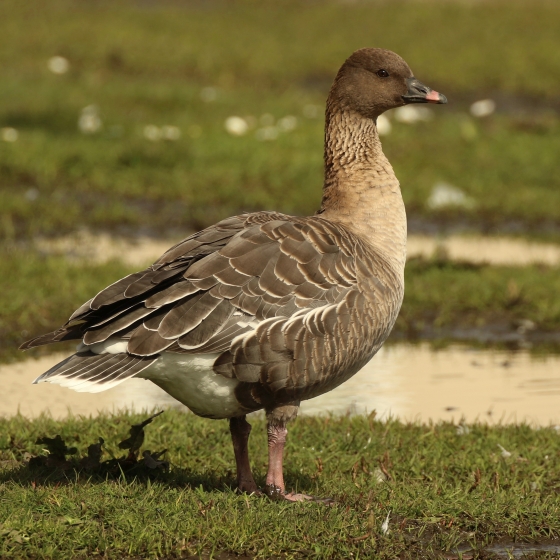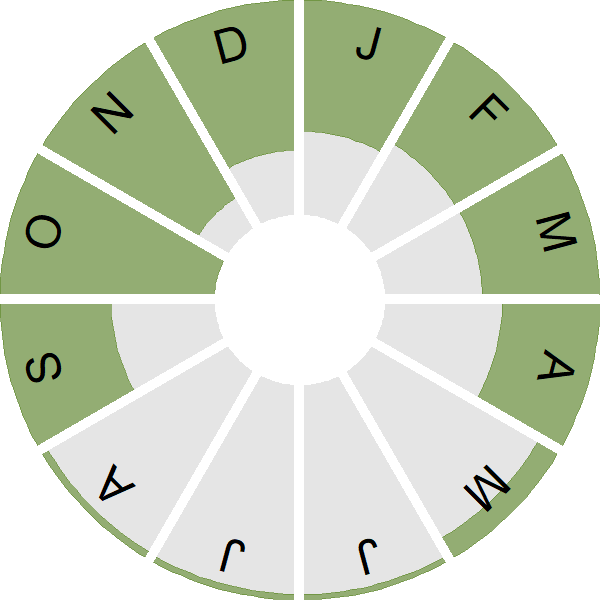Pink-footed Goose

Introduction
Pink-footed Goose is one of the so-called 'grey' geese, smaller and more compact than the more common Greylag, with a higher pitched call.
The entire Icelandic and eastern Greenlandic population of this species comes to Britain in winter, making these islands an internationally-important destination for more than a quarter of a million birds. Bird Atlas 2007–11 shows their winter distribution is focused on Scotland's eastern coastal plain and lowlands, together with a broad sweep of northern and eastern England.
A substantial population increase over the last 40 years, and a doubling of the wintering range within Britain, means that skeins of migrating Pink-footed Geese are a common sight. A sizeable proportion of these birds fly to the Norfolk's north coast, where they feed on discarded sugar beet tops after harvest.

Key Stats
Identification
ID Videos
This section features BTO training videos headlining this species, or featuring it as a potential confusion species.
Grey Geese (Revisited)
Songs and Calls
Call:
Status and Trends
Conservation Status
Population Change
The Pink-footed Goose is predominantly a wintering species in the UK; however, a very small number of individuals occasionally summer here. These are usually (but not always) injured birds that are unable to migrate. There have only been confirmed breeding records of apparently wild Pink-footed Geese once, in 2010, when pairs fledged young in Cumbria and Highland Holling et al. 2012]. The wintering population in the UK, which comprises birds from the Icelandic and Greenlandic breeding populations, has increased considerably from the mid 1950s [Gill et al. 1997, Fox et al. 2010] but [WeBS data suggest a slight decline since the mid-2010s. The UK population is localised in its distribution, wintering predominantly in eastern and southern Scotland, Lancashire and Norfolk Austin, G.E. et al. 2014.
Distribution
Each autumn the entire population of Pink-footed Geese breeding in Iceland and eastern Greenland migrates southeast to winter almost exclusively in Britain, where flocks favour intensively farmed lowlands, and generally avoid upland areas. This species is uncommon in Shetland, northwest Scotland, Ireland, Wales, southwest and southern England. In Scotland it is found along the eastern coastal plain, through the central lowlands, mainly in the east, and around the Solway Firth. In England it is found mainly in a broad band from Lancashire across to Lincolnshire and Norfolk, though the winter relative abundance map suggests that the highest densities are found close to the coast.
Occupied 10-km squares in UK
2007/08–10/11
or view it on Bird Atlas Mapstore.
2008–11
or view it on Bird Atlas Mapstore.
European Distribution Map
Distribution Change
A large population increase has resulted in a doubling of the British range size since the 1981–84 Winter Atlas. Gains have taken place throughout the range, but are most noticeable in England, northeast Scotland and the Northern Isles.
Change in occupied 10-km squares in the UK
from 1981–84 to 2007–11
or view it on Bird Atlas Mapstore.
from 1968–72 to 2008–11
or view it on Bird Atlas Mapstore.
Seasonality
Pink-footed Geese are locally very common winter visitors, arriving in September and present through to April/May. Odd individuals and naturalised birds may be encountered in summer.
Weekly pattern of occurrence
The graph shows when the species is present in the UK, with taller bars indicating a higher likelihood of encountering the species in appropriate regions and habitats.

Movement
Britain & Ireland movement
Foreign locations of birds ringed or recovered in Britain & Ireland
Dots show the foreign destinations of birds ringed in Britain & Ireland, and the origins of birds ringed overseas that were subsequently recaptured, resighted or found dead in Britain & Ireland. Dot colours indicate the time of year that the species was present at the location.
- Winter (Nov-Feb)
- Spring (Mar-Apr)
- Summer (May-Jul)
- Autumn (Aug-Oct)

European movements
EuroBirdPortal uses birdwatcher's records, such as those logged in BirdTrack to map the flows of birds as they arrive and depart Europe. See maps for this species here.
The Eurasian-African Migration Atlas shows movements of individual birds ringed or recovered in Europe. See maps for this species here.
Biology
Productivity and Nesting
Nesting timing
Egg measurements
Clutch Size
Survival and Longevity
Survival is shown as the proportion of birds surviving from one year to the next and is derived from bird ringing data. It can also be used to estimate how long birds typically live.
View number ringed each year in the Online Ringing Report.
Lifespan
Survival of adults
Survival of juveniles
Biometrics
Wing length and body weights are from live birds (source).
Wing length
Body weight
Ring Size
Classification, names and codes
Classification and Codes
- Order: Anseriformes
- Family: Anatidae
- Scientific name: Anser brachyrhynchus
- Authority: Baillon, 1834
- BTO 2-letter code: PG
- BTO 5-letter code: PIFGO
- Euring code number: 1580
Alternate species names
- Catalan: oca de bec curt
- Czech: husa krátkozobá
- Danish: Kortnæbbet Gås
- Dutch: Kleine Rietgans
- Estonian: lühinokk-hani
- Finnish: lyhytnokkahanhi
- French: Oie à bec court
- Gaelic: Gèadh-dearg-chasach
- German: Kurzschnabelgans
- Hungarian: rövidcsoru lúd
- Icelandic: Heiðagæs
- Irish: Gé Ghobghearr
- Italian: Oca zamperosee
- Latvian: isknabja zoss
- Lithuanian: trumpasnape žasis
- Norwegian: Kortnebbgås
- Polish: ges krótkodzioba
- Portuguese: ganso-de-bico-curto
- Slovak: hus krátkozobá
- Slovenian: kratkokljuna gos
- Spanish: Ánsar piquicorto
- Swedish: spetsbergsgås
- Welsh: Gwydd Droetbinc
Research
Causes of Change and Solutions
Causes of change
The estimated, total number of geese present across the Western Palearctic in winter rose by approximately two million birds between the mid-1990s and 2009; this increase included an additional 100,000 Pink-footed Geese from the Icelandic population [Fox et al. 2010]. This study suggested that one reason for this increase is the adaptability of herbivorous geese in exploiting widely available agricultural crops (cereal, root and grass). Other factors behind the success of this species group are thought to be a decrease in hunting pressures on the staging and wintering grounds, a decrease in human persecution on the breeding grounds, more refuge areas, improved winter feeding conditions and climate change [Madsen et al. 2012].
More Evidence
More evidence from Conservation Evidence.com
Partners
Citing BirdFacts
If you wish to cite particular content in this page (e.g. a specific value) it is best to use the original sources as linked in the page. For a more general citation of the whole page please use: BTO (20XX) BirdFacts Species: profiles of birds occurring in the United Kingdom. BTO, Thetford (www.bto.org/birdfacts, accessed on xx/xx/xxxx).

